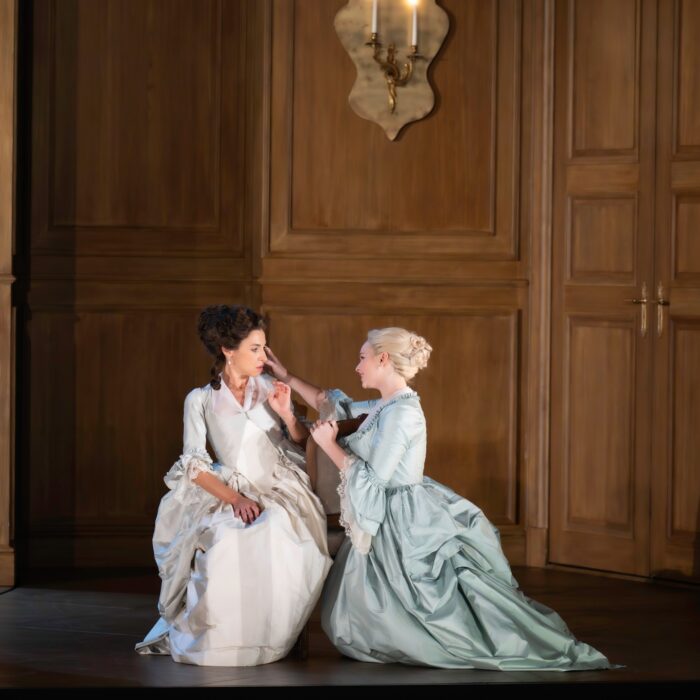
Opera Meets Film: The Wagnerian Leitmotif Exemplified By ‘The Duel of the Fates’ in the Star Wars Saga
By David Salazar“Opera Meets Film” is a feature dedicated to exploring the way that opera has been employed in cinema. We will select a section or a film in its entirety, highlighting the impact that utilizing the operatic form or sections from an opera can alter our perception of a film that we are viewing. This week’s installment, given the fact that the latest Star Wars movies are set to hit theaters features a look at the saga as a whole.
There is no direct opera quotation in any “Star Wars” movie. But that doesn’t mean that the space opera is not operatic. In fact, as is the case with many fantasy series, the film saga (which is now a whopping nine films long), operatic constructs when it comes to the music are very much a part of its inner works.
More specifically, “Star Wars” is built on leitmotifs. Wagnerian leitmotifs.
Not As Simple As You Think
Entire books and dissertations could be and have been written in the musical language of the films. Composer John Williams has essentially taken what Wagner did in his “Ring des Nibelungen,” via Korngold and other early music composers, and done the same in the entire Star Wars movies. Now to be clear, one of the interesting functions of the leitmotif is not simply to denote the presence of a character when he or she is mentioned or appears on the scene. It is true that this is, in fact, the case in the Ring Cycle and especially “Das Rheingold,” but the latter works, including his other non-Ring works, are even more nuanced in their use. We get inversions of themes, we get reappearances that once meant one thing and then mean another (as is the case with the Brünhilde motif at the end of “Götterdämmerung” but was first introduced by Sieglinde in “Die Walküre”). We get motifs colliding with one another, transforming through different keys. As a result, their very meanings are called into question, the ideas and conflict they generate enhancing the depth of storytelling to new heights.
So what does this have to do with “Star Wars?” Williams’ own use of leitmotifs is just as nuanced in his use of storytelling throughout the films he composed for. In this writer’s opinion, nowhere is this more fascinating than in the underappreciated prequel trilogy.
Dueling Fates
People could make any claims they like about the quality of those films, but no one can contest the level of storytelling that Williams brought to Episodes I-III. Just to exemplify the brilliant use of the leitmotif in the vein of Wagner, we will look to “The Duel of the Fates.”
For those unfamiliar with it, here is an excerpt:
The leitmotif is exclusive, so far, to the prequel films, making its very first appearance in “The Phantom Menace’s” climactic lightsaber fight. While the text in Sanskrit is undeniably important, as is the case with most operatic selections in films, audiences will probably not pay much mind to it during the actual viewing experience. Its opening chorus immediately sets the stage for an operatic context.
Episode I & II – External to Internal Conflict
The leitmotif is rather prevalent in the prequel films, but only appears a handful of times, developing the story further with each appearance. As noted, its first appearance links it directly to the battle between Jedi and Sith and their competing philosophies at the core of this trilogy. In this context, there is no ambiguity about what the dueling fates, the conflict laid bare for all to see. While the Jedi win the day in the end through Obi-Wan Kenobi killing Darth Maul, the battle is not without loss as Qui-Gonn Jinn dies in the battle.
Its second appearance doesn’t come until the second film “Attack of the Clones’” midpoint, wherein Anakin Skywalker surges forth to seek out his kidnapped mother. Here the theme is not an external conflict, but an internal one, Anakin’s Jedi training being called into question by the fear and anger at potentially losing his mother, tenants of Sith power. The use of music here is foreboding, as it is with the first instance and the conclusion of its sequence is just as double-edged as the first appearance. Anakin does find his mother, but only to see her die. His soul suffers a blow when he commits mass genocide against the sand people thereafter.
Episode III – Motif Combinations / Full Circle
We don’t get another appearance of the motif again until “Revenge of the Sith” and here it appears twice. The first instance is the most subtle of uses, coming as Anakin tries to land a ship on Coruscant, his fate and that of Obi-wan, R2D2, and Chancellor Palpatine, and others, hanging in the balance. By this point, the motif has been thoroughly established as a battle between the opposing sides of the force and its appearance has been alone.
But in this instance, Williams combines it with another prominent motif – the Force Motif. This motif is often utilized as a reminder of the benevolence of the force, its heroic nature, and its will. In this moment (1:24 of the clip to be exact), Williams music tells us that the entire fate of the galaxy and the force hangs in the balance, Anakin tasked, as the hero of the force and its supposed chosen one, with saving his current Jedi master, and the man that will fatefully turn into his Sith master, Darth Sidious. It’s a subtle cue but one that emphasizes that this is the moment where Anakin’s fate is sealed. The force and its dueling fates are one in deciding that Anakin must be both Sith and Jedi – he is locked into his path. Anakin succeeds in his mission at the close of this sequence, but yet again, the end has some negative ramifications, emphasizing its ying-yang meaning.
By the time the motif returns it is again for the climactic battle between Sith and Jedi; it has come full circle from its very first appearance in “The Phantom Menace.” It starts off during Anakin and Obi-Wan battle on Mustafar before fully developing during the Yoda-Sidious battle. As the two most powerful masters duel in the Senate, the music’s full meaning comes to the fore. It is not only a battle for dueling philosophies but also political systems and entire ways of life. Once again, the dueling fates come to a contradictory ending – Obi-wan wins his battle but Yoda loses his.
This is but one way in which Williams develops a leitmotif ala Wagner throughout “Star Wars” and we see him do to different effect with love motifs or character motifs (Rey’s motif developing throughout the entirety of “The Force Awakens,” for example). Who knows what else the remaining saga films will bring and how musical material will be furthered in this vein, but there is no doubt that the leitmotif is strong with these films.


